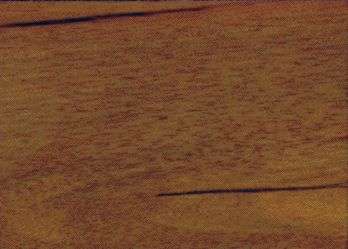
Ankyeyi (Diospyros sanza-minika)
Family: Ebenaceae
Common names: Ankyeyi, Dubima, Enkyinwine, Esono-afe, Esono-akyenie, Esonoakyi, Esunseka, Flintbark, Kusibiri, Liberia ebony, Okusibiri, Sanza minika, Sanzamouki, Sanzamulike
Distributed in: Gabon, Ghana, Ivory Coast, Liberia, Sierra Leone (Africa)
Common uses: Agricultural implements, Boat building (general), Carvings, Flooring, Fuelwood, Handles: general, Heavy construction, Joinery, Ladders, Mine timbers, Poles, Posts, Sporting Goods, Tool handles, Toys, Turnery, Vehicle parts
Tree size: Trunk diameter is 100-150 cm
Colors: the heart isWhite to cream, Yellowand the sapwoodStraight, Tan., the textureMediumand the lusterLow
Natural durability: Susceptible to attack from powder post (Lyctid & Bostrychid) beetles, Susceptible to marine borer attack
Odor: Has an odor
Silica Content: Siliceous
LightInduced Color Change: Darker
Kiln Schedules: Kiln Drying Rate (in days) is slow
Kiln Drying Rate: Very slow (>28 days for boards < 32 mm, to >84 days for boards >= 63 mm)
Drying Defects: Distortion, Resin Exudation
Ease of Drying: Thick Stock Requires Care
Tree Identification: Bole/stem form is straight
Comments: General finishing qualities are rated as good
Blunting Effect: Moderate
Boring: Fairly easy to very easy
Carving: Fairly Easy to Very Easy
Cutting Resistance: Fairly Difficult to Very Difficult to saw
Gluing: Fairly Difficult to Very Difficult
Mortising: Fairly Easy to Very Easy
Moulding: Fairly Easy to Very Easy
Movement in Service: Fairly Easy to Very Easy
Nailing: Possible if prebored, Very Good to Excellent
Planing: Planes well, to a good finish
Resistance to Impregnation: Sapwood is permeable
Response to hand tools: Difficult to machine
Routing recessing: Fairly Easy to Very Easy
Sanding: Fairly Easy to Very Easy
Steam bending: Poor to Very Poor Results
Screwing: Very Good to Excellent Results
; Turning: Fairly Easy to Very Easy
Polishing: Satisfactory; Staining: Fairly Difficult to Very Difficult
; Varnishing: Fairly Difficult to Very Difficult
;
- Numerical data Metric
- Numerical data English
- Strength properties
- References
 |
 |
 |
 |
| Item |
Green |
Dry |
Metric |
| Specific Gravity |
|
|
|
| Density |
|
897 |
kg/m3 |
| Bending Strength |
911 |
1388 |
kg/cm2 |
| Crushing Strength |
425 |
627 |
kg/cm2 |
| Hardness |
|
1333 |
kg |
| Impact Strength |
|
|
cm |
| Shearing Strength |
|
155 |
kg/cm2 |
| Stiffness |
117 |
135 |
1000 kg/cm2 |
| Tangential Shrinkage |
|
|
% |
| Radial Shrinkage |
5 |
|
% |
| Weight |
881 |
721 |
kg/m3 |
| Maximum Load |
|
|
cm-kg/cm3 |
| Toughness |
|
|
cm-kg |
| Static Bending |
|
|
kg/cm2 |
|
 |  |  |  | | Item | Green | Dry | English | | Bending Strength | 12968 | 19750 | psi | | Density | | 56 | lbs/ft3 | | Hardness | | 2940 | lbs | | Maximum Crushing Strength | 6047 | 8931 | psi | | Shearing Strength | | 2205 | psi | | Stiffness | 1665 | 1923 | 1000 psi | | Weight | 55 | 45 | lbs/ft3 | | Radial Shrinkage | 5 | | % | | Tangential Shrinkage | 8 | | % | |
Modulus of Elasticity (stiffness) = medium
Max. crushing strength = high
Bending strength (MOR) = high
Hardness (side grain) = very hard
Bending strength (MOR) = medium
Shearing strength (parallel to grain) = medium
Max. crushing strength = medium
Density (dry weight) = 61-67 lbs/cu. ft
Shrinkage, Tangential = moderate
Shrinkage, Tangential = large
Shrinkage, Tangential = fairly large
Shrinkage, Radial = moderate
Shrinkage, Radial = large
Shrinkage, Radial = fairly large
Density (dry weight) = 53-60 lbs/cu. ft
Density (dry weight) = 46-52 lbs/cu. ft.
Bending strength (MOR) = very high
Armstrong, F.H.,1960,The Strength Properties of Timber,Forest Products Research Laboratory, London Bulletin,No.45Bolza, E., Keating, W.G.,1972,African Timbers - the Properties, Uses and Characteristics of 700 Species,C.S.I.R.O. Div. of Building ResearchCooper, G.P., Record, S.J.,1931,The Evergreen Forests of Liberia,Yale School Forestry Bulletin,31,pp1-153Dalziel, J.M.,1937,The Useful Plants of West Tropical Africa,Crown Agents for the ColoniesErfurth, T., Rusche, H.,1976,The Marketing of Tropical Wood A. Wood Species from African Moist Forests,F.A.O. Forestry DepartmentGhana - Timber Marketing Board,1969,Ghana Hardwoods,Timber Marketing BoardIrvine, F.R.,1961,Woody Plants of Ghana,O.U.P. LondonKinloch, D., Miller, W.A.,1949,Gold Coast Timbers,Govt. Printer Gold CoastKryn, J.M., Forbes, E.W.,1959,The Woods of Liberia,U.S.A. Department of Agriculture,Forest Products Laboratory, Madison,,Report No. 2159Sallenave, P.,1955,Proprietes Phyiques et Mecaniques des Bois Tropicaux de l'Union Francaise,C.T.F.TSavill, P.S., Fox, J.E.D.,1967,Trees of Sierra LeoneTakahashi, A.,1978,Compilation of Data on the Mechanical Properties of Foreign Woods (Part,III) Africa,Shimane University, Japan, Research Report on Foreign Wood No. 7
|








